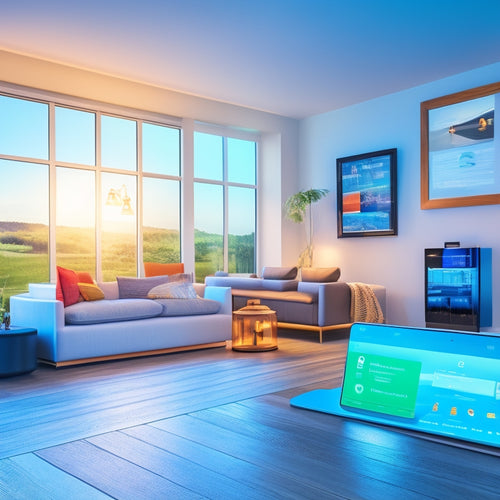
7 Earth-Saving Tips for Efficient Thermostat Programming
Share
You're about to reveal the secret to slashing your energy bills and reducing your carbon footprint: optimizing your thermostat programming. By adjusting your daily schedule to conserve energy when you're away, leveraging smart thermostat features, and dividing your home into separate temperature zones, you'll be well on your way to efficiency. Additionally, automate temperature adjustments, learn from energy usage data, and avoid overheating and overcooling to maximize your savings. Finally, track temperature trends and adapt to changing seasons to fine-tune your programming. As you get started, you'll discover even more ways to tailor your thermostat to your unique needs and make a bigger impact on the planet.
Key Takeaways
- Optimize your daily schedule by adjusting temperature when away from home, during work/school hours, and before bedtime to conserve energy.
- Leverage smart thermostat features like geofencing, energy-saving modes, and real-time energy usage data to automate energy optimization.
- Automate temperature adjustments based on daily routines, preferences, and vacation schedules to minimize energy waste and maximize convenience.
- Divide your home into separate temperature zones to prioritize room usage, reduce energy consumption, and maintain customized comfort.
- Analyze energy usage data to identify waste, track temperature trends, and fine-tune thermostat settings for optimal energy efficiency.
Optimize Your Daily Schedule
Since you're looking to maximize your thermostat's energy-saving potential, optimizing your daily schedule is an essential step.
Start by adjusting your morning routines to conserve energy when you're not home. Consider bumping up your thermostat by a few degrees during the day when you're at work or school.
For evening comfort, try setting it back down about an hour before bedtime. On weekends, adopt energy-saving habits like raising the temperature when you're outdoors.
Make seasonal adjustments to your thermostat to account for changing temperatures outside. By leveraging fast charging infrastructure and integrating energy-efficient solutions, you can reduce your carbon footprint.
If you work from home, adjust your schedule accordingly. Don't forget to set holiday settings and adjust for changes in home occupancy during vacation planning.
Leverage Smart Thermostat Features
You can optimize energy usage fast by utilizing your smart thermostat's advanced features, which learn your schedule and preferences to minimize waste.
By automating your schedule now, you'll eliminate the need for manual adjustments and reduce your carbon footprint.
Additionally, integrating renewable energy sources, such as solar-powered fast charging, into your daily routine can further decrease your energy consumption.
With smart features activated, you'll have access to real-time energy usage data, allowing you to make informed decisions about your heating and cooling habits.
Optimize Energy Usage Fast
Take control of your energy consumption by utilizing the power of smart thermostat features. You can optimize energy usage fast by adopting energy-saving habits and adjusting temperature settings to your advantage.
By integrating renewable energy sources, such as solar energy, into your home's power system, you can further reduce your carbon footprint.
Learn your schedule: Smart thermostats can learn your daily routine and adjust the temperature accordingly, ensuring you're not wasting energy when you're not home.
Use geofencing: This feature allows your thermostat to detect when you're approaching or leaving your home, adjusting the temperature to your preferred setting.
Set energy-saving modes: Many smart thermostats come with pre-programmed energy-saving modes that can help reduce energy consumption during peak hours or when you're sleeping.
Automate Your Schedule Now
By integrating your daily routine into your smart thermostat's programming, you can maximize energy efficiency and reduce waste.
Set your thermostat settings to align with your schedule, so it learns when you're home or away. This schedule consistency guarantees your thermostat adjusts temperatures accordingly, eliminating unnecessary energy consumption.
For instance, if you leave for work at 8 am, program your thermostat to lower the temperature by a few degrees during that time. By leveraging solar power efficiency, you can further reduce your reliance on fossil fuels and minimize your carbon footprint.
Similarly, if you're away on vacation, set your thermostat to an energy-saving mode. By automating your schedule, you'll enjoy a more comfortable home while doing your part for the environment.
Smart Features Unlocked
Frequently, smart thermostats come with advanced features that can greatly enhance your home's energy efficiency and comfort. By leveraging these features, you can take your thermostat programming to the next level.
For instance, optimizing energy production through strategic solar panel array design solar panel array optimization can also contribute to a more energy-efficient home. Additionally, selecting energy-efficient equipment, like those used in solar EV charging stations, can minimize losses and reduce operating costs.
-
Energy Saving Modes: Many smart thermostats offer energy-saving modes that can be activated when you're away or sleeping. These modes can adjust the temperature to use less energy while still maintaining a comfortable environment.
-
Remote Accessibility: With remote accessibility, you can adjust your thermostat from anywhere using your smartphone or tablet. This feature allows you to make changes on the go, guaranteeing your home is comfortable and energy-efficient when you need it to be.
-
Smart Scheduling: Some smart thermostats can learn your schedule and adjust the temperature accordingly. This feature guarantees your home is always at the right temperature when you need it, without wasting energy when you're not there.
Zone Control for Efficiency
You're likely familiar with the frustration of overheated or underheated rooms in your home, wasting energy and money.
Zone control is the solution, allowing you to achieve zone efficiency by dividing your home into separate temperature zones. This temperature zoning enables you to strike a comfort balance, distributing energy where it's needed most.
By setting customized settings for each zone, you can prioritize rooms based on usage, ensuring ideal climate control. This approach leads to significant cost savings and reduces your carbon footprint.
Integrating zone control with your existing system enhances space utilization, giving you more freedom to enjoy your home while staying environmentally conscious.
Automate Temperature Adjustments
With your zone control system in place, it's time to take your temperature management to the next level by automating temperature adjustments.
By leveraging advanced features, you'll enjoy greater convenience, energy efficiency, and freedom from manual adjustments.
To maximize the benefits, consider the following strategies:
- Schedule temperature changes based on your daily routine, seasonal preferences, and user settings.
- Integrate with temperature sensors to guarantee ideal temperatures in each zone.
- Enable remote access and energy alerts to stay informed and make adjustments on-the-go, receiving notifications when energy usage spikes or drops.
Learn From Energy Usage Data
You're about to access a wealth of understanding that'll help you optimize your thermostat programming.
By analyzing your energy patterns, you'll identify when and how you use the most energy, allowing you to make adjustments that reduce waste and lower your bills.
Tracking temperature trends will also reveal opportunities to fine-tune your thermostat's settings for maximum comfort and efficiency.
Analyze Energy Patterns
By examining your energy usage patterns, you can identify areas where you can make adjustments to optimize your thermostat's programming.
This analysis will help you understand your energy consumption habits, including when and how you use energy-intensive appliances.
-
Look for temperature fluctuations that occur when you're away from home or sleeping, and adjust your thermostat accordingly.
-
Identify the times of day when your energy consumption peaks and adjust your thermostat to reduce energy usage during those periods.
-
Analyze your energy usage data to determine if there are any energy-wasting habits, such as leaving lights or electronics on when not in use.
Track Temperature Trends
Temperature trend tracking is an essential step in fine-tuning your thermostat's programming, as it helps you understand how your home's temperature fluctuates throughout the day.
By monitoring these fluctuations, you'll identify patterns that impact your energy consumption. You might notice that your home cools down faster in the morning or warms up slower in the evening.
This knowledge enables you to adjust your thermostat's schedule to optimize energy usage. For instance, you can set it to cool or heat your home more efficiently during peak temperature fluctuations.
Adapt to Changing Seasons
As the seasons change, your thermostat programming needs to adapt to guarantee your home remains comfortable while minimizing energy waste.
You can't rely on a one-size-fits-all approach, especially if you live in an area with distinct climate considerations.
To make seasonal adjustments, consider the following:
-
Spring and Fall: As temperatures moderate, adjust your thermostat to use less energy for heating and cooling.
-
Summer: When it gets hot, raise your thermostat temperature to reduce cooling costs.
-
Winter: Lower your thermostat temperature to reduce heating costs when it gets cold.
Avoid Overheating and Overcooling
If you're not careful, your thermostat can become a major energy waster, especially when it's stuck in overheating or overcooling mode.
To avoid this, you need to master temperature regulation. Set your thermostat to a reasonable temperature - 68°F in winter and 78°F in summer - and stick to it.
Avoid drastic temperature changes, as they can cause your system to work harder, wasting energy.
You can also use programmable temperature settings to automate your temperature control, ensuring you're not overheating or overcooling when you're not home or sleeping.
Frequently Asked Questions
Can I Still Use a Traditional Thermostat With These Efficiency Tips?
You can still use a traditional thermostat, but you'll miss out on some major efficiency benefits. By incorporating thermostat programming tips, like scheduling and zoning, you'll reduce energy waste and lower your environmental impact.
How Often Should I Replace My Thermostat's Air Filter?
You should replace your thermostat's air filter every 1-3 months, depending on usage and air quality, to guarantee proper filter maintenance and breathe easy, enjoying cleaner air while keeping your thermostat running efficiently.
Do Energy-Efficient Thermostats Require Special Installation?
When upgrading to an energy-efficient thermostat, you'll need to evaluate installation cost considerations, but don't worry, you won't require special installation; most smart thermostat features can be self-installed or done by a handyman, saving you time and money.
Can I Control My Thermostat Remotely Without Wi-Fi?
Did you know 40% of energy is wasted on heating and cooling? You can break free from energy waste by exploring smart thermostat options with remote control features that don't require Wi-Fi, giving you freedom to control your temperature from anywhere, anytime.
Will a Programmable Thermostat Work With My Radiant Floor Heating?
You're wondering if a programmable thermostat will work with your radiant floor heating. The good news is that many thermostats are compatible with radiant heating systems, but you'll need to check your thermostat's compatibility before making a purchase.
Related Posts
-

10 Best WiFi Outlets for Tracking Home Energy Usage
You can optimize your home's energy usage with the right WiFi outlets, which provide real-time monitoring and control...
-

What Do Power Strips Do for Standby Energy?
You're likely aware that your devices, such as TVs and computers, continue to draw power even when turned off, a phen...
-

3 Eco-Friendly Automated Blinds for Contemporary Living
You're looking to raise your living space with automated blinds that not only exude contemporary style but also align...


